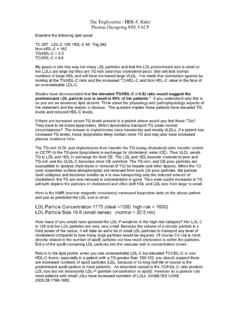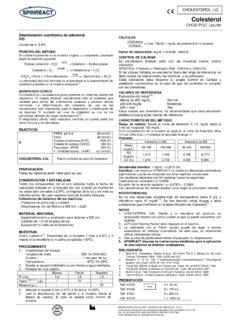Transcription of American Association of Clinical Chemistry - LipidCenter
1 American Association of Clinical ChemistryContois JH, et al. Clinical Chemistry 2009; 55:407-419 Contois JH, et al. Clinical Chemistry 2009; 55:407-419 LDL particles, not simply LDL-C, play a central role in atherogenesis. LDL particles move into the arterial intima through a gradient-driven process, and the rate of passive diffusion is increased when the concentration of circulating LDL particles is increased. Once inside the intima, the LDL particles bind to proteoglycans and initiate a process whereby the LDL particles become oxidized or other wise modified and are taken up by monocytes or macrophages to form foam cells or macrophages. The cholesterol molecules contained in the LDL are passengers, but the intact particles drive the atherosclerotic process. Recommendations from AACC Lipoproteins and Vascular Diseases Division Working Group on Best PracticesContois JH, et al.
2 Clinical Chemistry 2009; 55:407-419 Programs to standardize LDL-C, HDL-C, and triglycerides have met with only modest success, despite the widespread belief that these assays are accurate and reliable. ApoB standardization has fared much better with the success of the IFCC standardization project to improve apoA-I and apoB measurementsRecommendations from AACC Lipoproteins and Vascular Diseases Division Working Group on Best PracticesRecommendations from AACC Lipoproteins and Vascular Diseases Division Working Group on Best Practices LDL-C, non-HDL-C, LDL-P, and total apoB are all, to varying degrees, measures of LDL related risk. These cholesterol and particle measures are highly intercorrelated, which explains why they have all been implicated as predictors of CVD risk in epidemiologic studies, but biologically they reflect different entities.
3 Despite a high correlation, these markers are only modestly concordant, indicating that one cannot simply substitute for another in classifying patients into risk categories. We believe that the medical decision cutpoints should be set so that the apoB and LDL-P cutpoints are equivalent to those for LDL-C in terms of population percentiles. Contois JH, et al. Clinical Chemistry 2009; 55:407-419 Suggested Treatment GoalsRecommendations from AACC Lipoproteins and Vascular Diseases Division Working Group on Best PracticesApoB, mg/dLLDL-C, mg/dLNon-HDL-C, mg/dLLDL-P, nmol/L< 80< 100< 70< 100< 130< 80< 120< 150< 1100< 1400 Contois JH, et al. Clinical Chemistry 2009; 55:407-419 Population Distributions of LDL-C, non-HDL-C, ApoB and LDL-P in Framingham Offspring StudyPercentileLDL-C (mg/dL)Non-HDL-C (mg/dL)LDL-P (nmol/L)ApoB (mg/dL)270837205457894850621088104940692 0100119110078301111321220854012014313309 1501301531440976013916315401037014917516 7011080160187182011890176205202013095191 2242210140 ADA/ACCC utpoints 1 2 Contois JH, et al.
4 Clinical Chemistry 2009; 55:407-4191 Brunzell, et al. Diabetes Care 2008;31(4) medical decision cutpoints should be set so that the apoB and LDL-P cutpoints are equivalent to those for LDL-C in terms of population 2 Use of ApoB and LDL Particle Number in Clinical Management We do not believe that an apoB cutpoint equivalent to an LDL-C of 70 mg/dL ( mmol/L) is necessary at this time. We believe that a focus on reduction of LDL particles in very-high-risk patients is appropriate, and data are needed to determine optimal apoB and LDL-P target concentrations. However, a goal that is less than the 5th percentile of the population, as is an LDL-C 70 mg/dL ( mmol/L), may be unreasonable or from AACC Lipoproteins and Vascular Diseases Division Working Group on Best PracticesContois JH, et al.
5 Clinical Chemistry 2009; 55:407-419 Use of ApoB and LDL Particle Number in Clinical Management There are certain flaws with using the cycle 4 dataset from the Framingham Offspring Study to determine population equivalent cutpoints. The specimens were collected between 1988 and 1991, the vast majority of Framingham subjects were white, and the dataset excludes subjects with triglycerides 400 mg/dL ( mmol/L) to calculate LDL-C. There has likely been a shift in the distribution of lipids and lipoproteins over time so that what was once the 20th percentile is now the 30th percentile; however, the equivalence between a given percentile of apoB and LDL-C is unlikely to shift significantly. Also, although the relative risk associated with a given concentration of apoB or LDL-C may vary somewhat with race, the relationship between apoB and LDL-C with CVD risk is strong for all racial groups.
6 Therefore, we believe that these recommended cutpoints remain from AACC Lipoproteins and Vascular Diseases Division Working Group on Best PracticesContois JH, et al. Clinical Chemistry 2009; 55:407-419 Use of ApoB and LDL Particle Number in Clinical Management We agree that a greater emphasis on non HDL-C rather than LDL-C will improve patient care. Data from several prospective studies show non HDL-C to be a better predictor of cardiovascular events than LDL-C. In terms of relative risk, non HDL-C is consistently stronger than LDL-C and, in many studies, equivalent to apoB or LDL-P. However, apoB has been more extensively validated in epidemiological studies and Clinical trials than non HDL-C, and non HDL-C, like LDL-C, reflects the cholesterol content of atherogenic particles and not the number of atherogenic particles.
7 Importantly, on-treatment non HDL-C concentrations may not reflect residual risk associated with increased LDL particle numberRecommendations from AACC Lipoproteins and Vascular Diseases Division Working Group on Best PracticesContois JH, et al. Clinical Chemistry 2009; 55:407-419 Use of LDL Particle Number in Clinical Management Statins are highly effective in reducing serum cholesterol through inhibition of HMG-CoA reductase, which upregulates LDL receptors and leads to increased clearance of LDL particles from the circulation. However, the reduction in serum apoB or LDL-P concentration is not as dramatic as the reduction in LDL-C or non HDL-C. As a result, patients treated to goal for LDL-C may not have achieved correspondingly low LDL particle concentrations, leading them with potential residual risk.
8 Recommendations from AACC Lipoproteins and Vascular Diseases Division Working Group on Best PracticesContois JH, et al. Clinical Chemistry 2009; 55:407-419 Recommendations from AACC Lipoproteins and Vascular Diseases Division Working Group on Best Practices Because therapies with 3-hydroxy-3-methylglutaryl coenzyme A (HMG-CoA) reductase inhibitors reduce LDL-C to a greater extent than they do LDL particles, apoB or LDL-P appear to provide a better assessment of on-treatment residual risk than LDL-C measurement. Importantly, on-treatment non-HDL-C concentrations may not reflect residual risk associated with increased LDL particle number. In light of the mounting evidence, the members of this working group of the Lipoproteins and Vascular Diseases Division of the AACC believe that apoB and alternate measures of LDL particle concentration should be recognized and included in guidelines, rather than continuing to focus solely on LDL-C.
9 Contois JH, et al. Clinical Chemistry 2009; 55:407-419 Is Cholesterol a Reliable Measure of LDL Particle Concentration? Cholesterol has served as a useful surrogate for estimating LDL-related risk, but LDL-C concentration can vary widely between individuals with the same LDL particle concentration. LDL-C content does not reflect LDL particle concentration because metabolic reactions involving lipid can alter both lipoprotein size and lipid composition. Any measure of LDL-C, including the -quantification reference method, suffers from the fact that measurement of the cholesterol component of LDL does not consistently reflect the concentration of LDL particles in serum/plasma. Recommendations from AACC Lipoproteins and Vascular Diseases Division Working Group on Best PracticesContois JH, et al.
10 Clinical Chemistry 2009; 55:407-419 Although it is often considered to be a distinct risk factor, apoB is better considered an alternate measure of LDL-related risk because it largely reflects LDL particle concentration. Nuclear magnetic resonance (NMR) has more recently been introduced as another means of quantifying LDL particle number (LDL-P) concentration. Alternate Measures of LDL QuantityOptions for Measurement of LDL Particle ConcentrationRecommendations from AACC Lipoproteins and Vascular Diseases Division Working Group on Best PracticesContois JH, et al. Clinical Chemistry 2009; 55:407-419 Recommendations from AACC Lipoproteins and Vascular Diseases Division Working Group on Best Practices StudyBlake et al. 2002 Kuller et al. 2002 Rosenson et al.

















